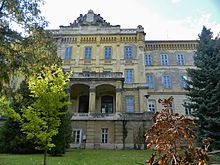Ludwig Zettl
Ludwig Zettl , since 1882 Knight von Zettl , (born May 5, 1821 in Groß Sbosch (Czech: Velké Zboží ) near Podiebrad , Austrian Empire ; † April 14, 1891 in Vienna ) was a Bohemian-Austrian architect , who was particularly known for his hospital buildings emerged.
Life
Ludwig Zettl was the son of the civil servant Johann Zettl from the Central Bohemian town of Poděbrady. He first attended the Polytechnic in Prague , and from 1843 to 1844 the Polytechnic Institute in Vienna. He was then accepted as an intern in the court building council and at the same time studied at the Academy of Fine Arts Vienna in the architecture school until 1847 . After completing his studies, Zettl worked in the State Building Department, where he was very successful. From 1850 he was involved in the planning and execution of most of the state hospitals and penal institutions. When the State Building Department came under the Ministry of the Interior in 1859, Zettl was kk thereEngineer 1st class. From 1859–1865 he was a member of the Vienna Building Commission and, as a technical representative of the Ministry, a member of the City Expansion Commission. Zettl became chief building officer and received numerous other awards in addition to the Franz Joseph Order . With the award of the Order of the Iron Crown III. Class 1882 was connected to the elevation to the knighthood. From 1863 Zettl was a member of the Vienna Künstlerhaus .
plant
As a civil servant on behalf of the state, Ludwig Zettl carried out numerous social buildings, such as hospitals and prisons, throughout the Habsburg Monarchy . He played an important role in the planning of the Vienna Ringstrasse zone in the City Expansion Commission, where he also presented his own draft for the design of the Ringstrasse zone. The idea of a freight road running parallel to the Ringstrasse essentially came from him. In addition to his civil service work, Zettl also worked as a private architect and carried out some buildings within the ring road zone. Most of his buildings can be attributed to early historicism, but he also created neo-Renaissance forms .
- Mortuary and dissection facility in Wiedner Spital , Favoritenstrasse 32, Vienna 4 (1859), demolished after 1945
- Rudolfstiftung Hospital , Boerhaavegasse 8, Vienna 3 (1859–1864), construction management based on plans by Josef Horky; from 1970 replaced by a new building
- Legal-medical, pathological-chemical institute in the general hospital , Spitalgasse, Vienna 9 (1860)
- Hospital , Pressburg (1860)
- State insane asylum , Sibiu , Transylvania (1860)
- Rental houses Güntner , Spindlergasse (today: Döblergasse) 1–3, Vienna 7 (1861)
- Provisional House of Representatives "Schmerlingtheater" , Währinger Strasse 2–4, Vienna 9 (1861), demolished
- Adaptation of the country house as a mansion , Herrengasse , Vienna 1 (1861)
- Christinenhof , Schubertring 9 / Kantgasse 6 / Christinengasse 2–4 / Pestalozzigasse 1–3, Vienna 1 (1862)
- Rental houses , Rasumofskygasse 10–14, Vienna 3 (1863), not identifiable; probably canceled
- Rental house , Kleeblattgasse 11, Vienna 1 (1863)
- Rental house , Tuchlauben 15 / Kleeblattgasse 13, Vienna 1 (1864)
- Leitenberger residential and department store , Franz-Josefs-Kai 51, Vienna 1 (1865), demolished after 1945
- Rental houses , Pillersdorfgasse 2-6, Vienna 2 (1865), facades simplified
- Rental houses , Pillersdorfgasse 1–5, Vienna 2 (1865), No. 3 demolished after 1945; No. 5 decor preserved
- Residential building and washing facility of the kk Theresian Knight Academy , Alleegasse, Vienna 4 (1865), today Argentinierstrasse; not identifiable
- Lipótmezö Psychiatric Hospital , Budapest (1868), a listed building
- Tenement house of the Seitenstetten Monastery , Kohlmessergasse 3–5, Vienna 1 (1869), incorporated into the Franz-Josefs-Kai after 1945; tore off
- Mandl residential and commercial building , Werdertorgasse 5–7, Vienna 1 (1869–1870)
- Palais Wehli , Elisabethstrasse 5 / Operngasse 5, Vienna 1 (1869–1871)
- Proskowetz rental house , Wohllebengasse 6, Vienna 4 (1869), demolished after 1945
- House Proskowetz , Wohllebengasse 4, Vienna 4 (1870) 1912 by a new structure of Krauss and Tölk replaced
- Hospital and Maternity and Foundling Asylum , Cracow , Galicia (1870)
- Neuer Schottenhof , Helferstorferstraße 4 / Rockhgasse 2, Vienna 1 (1871–1874)
- Palais Leitenberger , Parkring 16 / Himmelpfortgasse 31–33 / Hegelgasse 3, Vienna 1 (1871–1875), a listed building
- Rental house Biro , Reisnerstraße 61, Vienna 3 (1873)
- Palais Mayr-Melnhof , Seilerstätte 13 / Johannesgasse 21, Vienna 1 (1874–1875), decor largely removed
- Rental house , Neubaugasse 65, Vienna 7 (1875)
- Imperial and Royal Ministry of the Imperial House and the Exterior , Ballhausplatz 2, Vienna 1 (1883), renovation and new building
- Lunatic Asylum , St Petersburg
literature
- Constantin von Wurzbach : Zettl, Ludwig Ritter von . In: Biographisches Lexikon des Kaiserthums Oesterreich . 59th part. Kaiserlich-Königliche Hof- und Staatsdruckerei, Vienna 1890, p. 351 ( digitized version ).
Web links
- Ludwig Zettl. In: Architects Lexicon Vienna 1770–1945. Published by the Architekturzentrum Wien . Vienna 2007.
| personal data | |
|---|---|
| SURNAME | Zettl, Ludwig |
| ALTERNATIVE NAMES | Slip of paper, Ludwig; Note, Ludwig Ritter von |
| BRIEF DESCRIPTION | Austrian architect |
| DATE OF BIRTH | May 5, 1821 |
| PLACE OF BIRTH | Poděbrady |
| DATE OF DEATH | April 14, 1891 |
| Place of death | Vienna |



